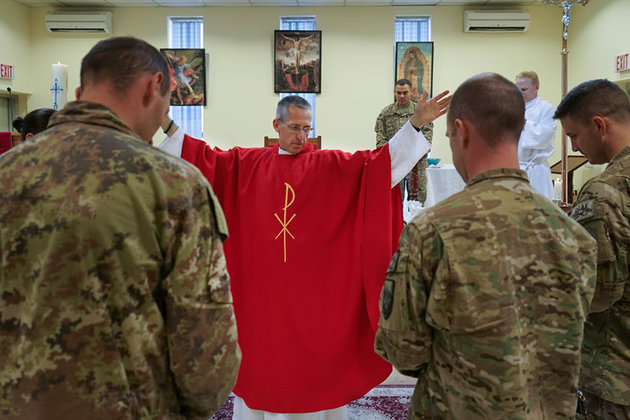Interview: “Chaplains” Director Martin Doblmeier
Posted on November 3, 2015 at 11:15 pm

“We have been around this world now for about 30 years making films and I know a lot of chaplains. And I realized that there had not been any kind of significant film that talked about the work that they do. And they work so quietly, under the radar most of the times. And I just felt maybe we could do something that helps to raise the profile and bring some attention to who these people are and the great work that they do. So once we started to dig into it and we realized that it was something that was becoming more common across faith traditions. There certainly had been chaplains dating back to the fourth century. St. Martin of Tours was the one who actually begun what has now become the idea of chaplaincy and it’s been going on now quietly mostly in the military or in a hospital setting but over the last couple of generations has expanded now into the prisons. Even the corporate world is looking at it as an interesting model, that’s why we put Tyson’s in there. We had known about Tysons for many years actually. I keep notes in piles. The foundations liked this idea because it had something of positive value. And with their support we were able to get it up and get it going. For me I think it’s a really interesting storyline about people who want to live out a faith tradition in the 21st century in their particular place. And what a wonderful model for how not just to tolerate the faith tradition of others but actually to honor it, and engage with it and to see it as a way to sort of forming a sense of meaning in our lives.”
Congregational clergy spend almost all of their time with people who share their faith traditions and culture, but chaplains work with people who of all faiths and of no faith. “In a congregation really pretty much the language is common, the rituals are common, the practice is common, and people generally understand that the pyramid of structure is with the pastor or the Imam or the Rabbi being the person in charge of the spiritual growth of that particular community. It’s a totally different paradigm in chaplaincy, most often because they are working in secular settings, they don’t really have a place that you would consider to be a power position in those settings and so they are negotiating every day not only with the institution but how to deal with the individual that they come across. And it’s a very different way of being present in those kinds of environment than it would be in a congregation. I think it’s a wonderful model but it presents its own challenges. One of the things we wanted to bring out in the film is that you’re working in a spiritual realm, that it is very difficult, nearly impossible to somehow document the impact that the chaplain would have in a hospital setting or in a prison setting.” Because they are in secular settings, they constantly need to find ways to demonstrate their value in terms that the people responsible for those settings can understand. “There are implicit success points that you can look at but at the same time in institutions that are under a lot of pressure for accountability and quantifiable data to be able to say this person is actually contributing a lot to our overall mission here in the secular settings is a challenge. Chaplains don’t often have that kind of data. So there is a constant stance of — ‘Will I still have this job? Will I still be able to continue to perform this work after the next review happens?’ I had a real sense of admiration for them, the commitment that they have despite the fact that in many cases the roles that they play in the hospitals or in the prison settings are always being evaluated and reevaluated.”
The movie shows that the work of the chaplains often extends past the boundaries of the community they are serving. “For example in the police department my assumption was the police chaplains would be meeting with perpetrators or prisoners or people who have been arrested or incarcerated for whatever reason. In fact, more often than not the police chaplains were mostly ministering to the police department. And I find that to be the case in a lot of different ways. So in hospital settings the hospital chaplains often ministered to the patients and the patient’s families, the people involved but they also minister a lot and provides support, emotional support, spiritual support to the staff, to the doctors and the nurses. So they do provide this sort of wider setting of what’s going on and I think we tried to show that in each one of the different segments because I think there can be a lot of misunderstanding to what their role is but they continue to sort of be present and available to those people who need them, very different to the settings in the military.”

Perhaps the most unexpected setting in the film is Tyson’s Food. Doblmeier says that the success of this program, particularly in providing support for employees from a wide variety of ethnic and cultural backgrounds. “There are companies now that are providing chaplain services like you provide independent IT services. Corporations that have evangelical leadership feel as though it is important for them to be able to have access to chaplaincy. So that they can literally hire in through an agency chaplains to come in and serve their people. We wanted to do it because Tysons Foods is huge publicly traded company and it has not just a handful of chaplains to come in and sort of maybe address some of the spiritual needs. It has 120 full and part-time chaplains and has had them now for you while. So this is a genuine commitment on the part of this corporation. John Tyson is not an evangelical; he is an Episcopalian. He just feels as though this is a good thing for a company. And this is a publicly traded company which comes under a lot of scrutiny; all the dollars that are spent are scrutinized because there is shareholder and stakeholder interest but he still believes that the bottom line is best served by having a team of chaplains there.”
Doblmeier says that what chaplains can do is help people facing challenges like loss, risk, and illness with “a sense of meaning and purpose in their lives. And the role of the chaplain is again not to give them their own meaning and infuse them with the notion of their own spirituality and sacredness but to help the individual tap into innately what they believe is the source and meaning of life. That’s the kind of support that the person is really coming up for. Sometimes there is such a close link between the individual and the chaplain that the individual may start to choose openly, freely the spiritual path of a chaplain and that’s quite okay but a good chaplain doesn’t seek to bring that person into a fold, they seek to have that person find what’s going to really be substantive meaning in their own life. And sometimes it’s very brief. These hospital settings can be just a matter of days and so the skill you have to have is to have the ability to get a quick spiritual assessment. In other cases its long-term, that chaplain is in the prison setting is trying to help somebody who may never get out of that 5 x 8 prison cell that they live in. How do you find purpose and meaning in your life then? They are really to be present to the person to help that person discover or in some cases rediscover what gives them a sense of purpose after a loss, spiritual or emotional loss and then help them get them back on track.”



